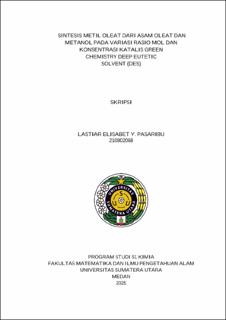Sintesis Metil Oleat dari Asam Oleat dan Metanol pada Variasi Rasio Mol dan Konsentrasi Katalis Green Chemistry Deep Eutetic Solvent (DES))
Synthesis of Methyl Oleate from Oleic Acid and Methanol on Mol Ratio and Concentrations of Green Chemistry Deep Eutetic Solvent (DES) Catalyst

Date
2025Author
Pasaribu, Lastiar Elisabet Y.
Advisor(s)
Tarigan, Juliati Br
Metadata
Show full item recordAbstract
The synthesis of methyl oleate from esterification reactions between oleic acid and methanol used green chemistry deep eutectic solvent (DES) catalyst using homogenizer. DES catalyst is prepared by mixing of choline chloride (ChCl) as hydrogen bond acceptor (HBA) and urea as hydrogen bond donor (HBD) at a mole ratio 1:2. Synthesis of catalyst was carried out by heating and stirring method until a homogenous DES catalyst solution was formed. The esterification process was carried out with various concentration of the DES catalyst (9, 12, 15, 18, 21% w/w) with mole ratio of oleic acid to methanol (1 :1, 1:3, 1:6, 1:9, 1:12, 1:15, 1:18, 1:21) with a stirring speed of 5000 rpm with a reaction time 10 minutes for each variation. The reaction product were analyzed by Infrared Spectroscopy (FT-IR) and Gas Chromatography (GC). The maximum conversion based on SNI 7709:2012 and yield of methyl oleate for the variation of catalyst concentration were obtained at the reaction conditions under 15% DES catalyst concentration, mole ratio of oleic acid : methanol 1:15, stirring speed of 5000 rpm and 10 minutes reaction time, which amounted to 98,7 ±0,3% and 85,9 ±1,3%. The maximum convertion for the variation of mole ratio of oleic acid to methanol was 1:3, catalyst concentration 15%, stirring speed of 5000 rpm and 10 minutes reaction time were used which amounted to 97,7 ±0,3%. The highest yield for the variation of mole ratio of 1:18, catalyst concentrations of 15%w/w, reaction time 10 minutes, and stirring speed of 5000 rpm reached an average yield of 79.8%. The analysis results of gas chromatography showed that the methyl ester reached 87,17% and analysis FT-IR spectrophotometer shows that there is absorption of -C=O stretching ester at wave number 1744,4 cm-1 and there is no stretching vibration of carboxylic acid -OH groups in the wave number area 2500-3000 cm-1 and supported by the characteristic stretching absorption band of the -C-O group at 1170,4 cm-1 area. So that it can be concluded that there has been a process of substitution of the -CH3 group for the H atom of the -OH group of oleic acid.
Collections
- Undergraduate Theses [1420]
